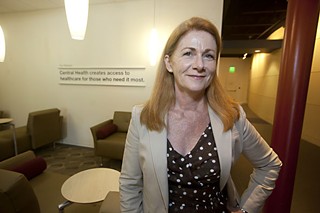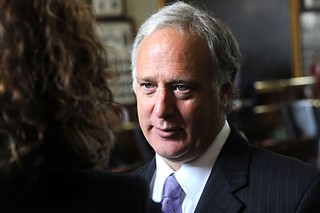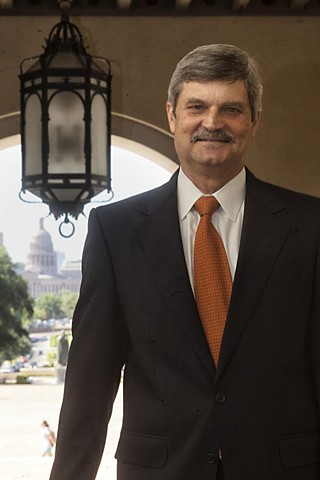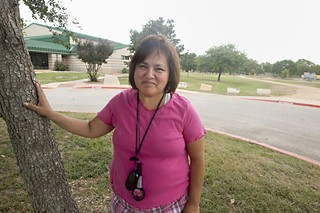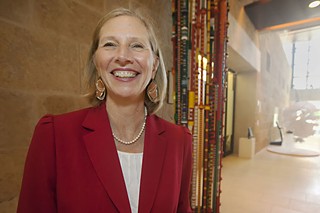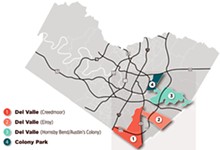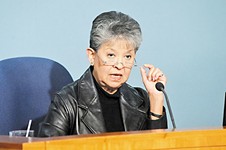The Med School Solution
Can a Central Health/UT-Austin/Seton medical school project – and its spinoffs – fill the gaps in Travis County health care?
By Mike Kanin, Fri., Sept. 14, 2012
The morning of Sunday, Aug. 19, the president and CEO of Travis County Central Health, Patricia Young Brown, woke to find her face spread across the first page of the Austin American-Statesman's Metro section. In a Q&A by the paper's Mary Ann Roser, Brown, Central Health's Chief Communications and Planning Officer Christie Garbe, and Chief Financial Officer John Stephens tried (as the Statesman put it) to go "Behind the Tax Increase" that the organization will ask voters to approve on
Nov. 6.
Roser's first question echoed what has been the issue of the moment for Travis County residents, university students, future university students, and political observers from around the state: "Why should Travis County taxpayers help pay for a medical school?"
Ever since Austin state Sen. Kirk Watson first unveiled the idea at a Real Estate Council of Austin event last September, regional agencies and governments have scrambled to find funding possibilities for the massive project, which could run the involved parties (all told) as much as $4.1 billion over 12 years. At last check, the University of Texas is on board for at least a $25 million annual contribution that would climb to $30 million over the first eight years of the school's existence. Central Health, according to the Statesman, would cough up about $35 million annually over 12 years – or a total of $420 million. The Seton Healthcare Family expects to provide nearly $2 billion, including $250 million that would ultimately result in a replacement of its aging but centrally located Brackenridge hospital facility.
Beyond all of that, Central Health – through a new 501(c)(3) nonprofit entity it has formed with Seton – plans to explore the possibility of drawing down funds from a federal Medicaid program colloquially known as the "1115 waiver." Under that provision, if the various entities involved in a potential medical school can demonstrate that they are paying for an assortment of new projects that will transform the delivery of health care in the region – ultimately to the benefit of Medicaid patients – they can tap the U.S. government for $1.46 for every dollar they spend. Thus, $1 million becomes $2.46 million, $100 million becomes $246 million, and so on.
But to make it all work, Central Health is asking for a tax increase, to be placed before voters on Nov. 6. Watson asked for a raise of five cents per $100 of property valuation; Central Health's board obliged, endorsing that increase, which would bring the district's rate to just over 12 cents for every $100 of property valuation. In dollar figures, that would mean (if voters approve) that someone who lives in a home valued at $200,000 would see an increase of $100 on their annual tax bill.
Should We Leap?
This brings us back to Roser's question: "Why should Travis County taxpayers help pay for a medical school?" Brown's response was measured, hopeful, and vague. "What residents are paying for is health care delivery to the community. We're not building buildings. What we're proposing to do is pay for care through medical school faculty, residents [doctors in training] and medical students," she told Roser. "We're also trying to leverage an amazing opportunity we have been presented ... [with] the 1115 transformational waiver to essentially support this new delivery system, the expansion of services and the creation of a new teaching hospital and new medical school. All of these bring more services to our community."
Her words could well have been pointed toward the Southeast Austin community of Dove Springs, where for roughly two decades residents have been looking for an adequate solution to their public health needs. The success of the medical school as a community project will to a degree depend on whether residents of Dove Springs (and similarly underserved regional communities) finally get their needs addressed. Come November, the citizens of Travis County will be asked for a massive down payment on that promise.
With Watson quietly twisting official arms, the word around the various regional governmental entities was to keep all other fiscal ballot requests to a minimum. The city of Austin bond advisory task force trimmed an ambitious, nearly $600 million bond package to $400 million, which was cut to just $385 million by City Council after Mayor Lee Leffingwell insisted he didn't want a proposal that would force the city to raise taxes. The Austin Independent School District delayed its request for a tax increase at least a year ("This was not our year," AISD Board President Mark Williams told the Community Impact Newspaper). Travis County appears headed for a modest tax increase, but county officials accomplished a large bond issue last fall. Neil Vickers, Austin Community College's associate vice president of finance and budget, has called his organization's 0.3% tax increase proposal "relatively flat."
The promises from Central Health, the willingness of other parties to make room for a health district tax increase on the November ballot, the push from Watson that makes it all go: A medical school may not be completely preordained, but it sure has the markings of incarnation. Yet notwithstanding the potential 1115 waiver dollars, furious nodding from officials, and the uncertain endorsement of Travis County voters, the fundamental question remains: Can a medical school in Central Austin transform the way we deliver health care, especially to the lower-income residents of the far-flung capital region, in a way that no other approach could?
Should we make the investment?
Your Medical History
Modern local public health in Texas goes back at least as far as a 1953 state bill that allowed for the creation of "hospital districts" – entities that could use property taxing power to raise funds to build public hospitals, clinics, and the like. Dallas County took advantage of the option in 1954. Bexar followed in 1955, El Paso in 1958, Tarrant in 1959, and Harris in 1966. Nueces County had one by 1968.
But in Travis County, only the public hospital itself – Brackenridge, which dates back to the 19th century – boasts any kind of history. For decades, the facility – especially its emergency room – has served as the city's health care safety net. There were also community clinics managed by the city of Austin. With hospital consolidation making single-facility operations more difficult in the 1990s, the city asked Seton to take over at Brackenridge in 1995.
Young Brown tells the Chronicle that this was a most uncommon situation for Texas. "Seton took on full financial operating risk of Brackenridge," she says. The arrangement was not one that the city was eager to shake. But as the region continued to grow, so did its population of un- and underinsured. With pressure on the system mounting, voters approved the creation of Travis County's Central Health district in 2004 – more than a half-century after the Texas Legislature gave counties that power.
The district inherited whatever taxing jurisdiction that Austin and Travis County had in terms of community health. According to its current mission statement, the organization uses those funds to create "access to health care for those who need it most."
Yet, despite clear needs for public health care in and around the capital region – and a diminishing commitment from the state – Central Health has held its tax rate at a relatively stable figure that generally hovers between six and eight cents for every $100 worth of property.
A look at the per capita tax impact – property-value neutral – puts this in perspective. In FY 2012, Dallas County residents paid an average of $172 per person to their hospital district. Tarrant County residents coughed up $149. The Bexar County Hospital District drew $162 per person; El Paso, $86; Harris, $122; and Nueces, $91.
By contrast, Travis County residents currently pay just $71 for their hospital district. Young Brown says the district, like most local jurisdictions, has relied on the rise in property values to fuel an increase in funding that allowed it to keep its tax rate relatively stable since its creation. In an odd refrain more fitting perhaps for Lubbock County – which has had a hospital district since 1967 – Central Health officials call this doing "more with less."
"We have been very conservative stewards of the public funds," Young Brown says. But, she says, such a low tax rate is "not sustainable over time."
The Funding Puzzle
Central Health has kept its tax rate relatively stable for eight years; that appears likely to change. Two legislative actions served as harbingers of the end of that policy. The first came in 2007, when, with Watson leading the way at the Legislature, the district was able to secure for itself the right to tax above its rollback rate with voter approval.
The second came with the passage of 2011's Senate Bill 7. As the Chronicle reported last month ("Will Medicaid Build a Medical School?," Aug. 3), that bill was signed by Gov. Rick Perry shortly before he formally announced his disastrous run for president. Indeed, the signing ceremony for SB 7 might as well have served as would-be Pres. Good-Hair's coming-out ceremony. The Texas Tribune noted that the bill was "a fan favorite for abortion opponents, because it includes amendments aimed at taking more family planning dollars away from outfits like Planned Parenthood, and barring hospital districts that use tax revenue to finance an abortion from getting state funding."
But SB 7 may also have opened the door to a major infrastructure victory for Central Texas health care. In addition to throwing out red meat for red-staters, the bill also merged the Rio Grande Valley's Medicaid program into the rest of the state's Medicaid managed care efforts. It was the last such region to be so incorporated; with all of Texas' Medicaid programs now under managed care, each of those regions loses a substantial portion of Medicaid reimbursement for health care costs formerly picked up by the federal government. The Medicaid 1115 waiver program was set up to offer eligible health care regions the opportunity to replace that funding through a process by which the districts have to prove that they are working to "transform healthcare delivery" in a positive way. If Central Health can demonstrate that, it would also be able to bring home $1.46 in matching federal money for every $1 it spends. It's by that math that Central Health hopes to turn $54 million in tax revenue – roughly what the proposed tax increase would bring in – into a $133 million jackpot.
Perry signed SB 7 on July 18, 2011. Two months later, Watson unveiled his "10-in-10" plan, a list of 10 health care goals for the region that he represents. At the top of the list was the construction of a medical school for UT. That was followed by such idealistic possibilities as the establishment of a "modern teaching hospital," a call to "improve basic infrastructure, and create a sense of place," and acknowledgement of a need to "provide needed behavioral health facilities and services."
In his remarks, Watson connected the recent history of Austin's academic-cum-economic prowess, as he sees it, to a bright future version of the place that is already primed, if not set, for the coming of a centerpiece university medical facility. "An economy that was once known mostly for its students, professors, and government workers is [now] world-famous for the technological devices it builds and the ideas it produces," Watson said. "But it would be a mistake to treat medical education and research like it's some new song from an old band we all liked back in the Seventies. You don't just drop the semiconductor wafer, pick up a scalpel, and keep going the way you've been going. This isn't simply another version of something we already know.
"This is new, and it's potentially bigger than any of us have ever seen."
It's a refrain reverberating from Watson, through UT, to the local politicos who've either all lined up behind the idea or are unwilling to talk on the record about any of its shortcomings. Two of Watson's 10-in-10 goals stand out: No. 3, "Foster modern, uniquely Austin health clinics," and No. 10, "Solve the funding puzzle." As it happens, these two items are linked.
The answer to Watson's funding puzzle involves the partnerships with Seton (which, remember, is on the hook for $250 million in a new facility, and up to $1.9 billion total), UT (at least $25 million a year for operating costs), and Central Health ($35 million). Central Health's contributions will be tied to a proposed list of projects that it will send to Washington in asking for that $1.46 in matching funds for each dollar spent. That list (www.texasregion7rhp.net/info-for-partners) currently includes 25 specific regional community health care projects that cover a broad swath of health care issues, from improved access to behavioral care, to a boost to women's cancer care and screening, to what Central Health calls a "family-centered pediatric obesity program."
One limitation with 1115 funds, however, is that they're for projects – they can't be used for capital improvements. Central Health, at least, won't be building anything new with the funds brought back from the federal government. With most of the five-cent tax increase ticketed for the 1115 projects, it is safe to say that, with this tax increase, Travis County residents won't be buying any new clinics.
Central Health would, theoretically, use those 1115 funds to create the promised community portion of the medical school plan. The plan reads something like this: UT creates the school, Seton builds the hospital, incoming doctors and future doctors flood the region and fill the programs established by Central Health. If it all works, there should be more doctors available to staff facilities such as the existing Dove Springs clinic. The prevailing feeling among med school supporters is that the influx of doctors could be enough to address health care issues like those of Dove Springs.
A Texas Problem ...
Young Brown sees the medical school, and all that it will bring with it, as an opportunity for Travis County to partner with other agencies so that it can extend its reach in the community. She points to the lack of physicians in the area, the first-class residents that supporters hope the medical school will attract, the programs that already exist in the community, and the leverage offered by the federal 1115 waivers. "We're really taking advantage of a once-in-a-lifetime confluence of opportunities," she says. "We're using the waiver dollars to serve the population that we are responsible for."
"It is simply not going to be sustainable for [Central Health] to meet its mission if we continue to fall deeper and deeper into a hole with not enough doctors," said Watson. "We know that medical students and residents and doctors-in-training in other communities play significant roles in providing that health care. In addition, we need the ability to build out a better overall system."
"For Central Health to meet its mission, new resources and more resources are absolutely necessary," Watson later added. "Then those have to be spent on expanding health services and coordinating health services, and also services that will support medical education – because there's just not enough doctors to do the job."
As for the question of whether the med school is an appropriate landing spot for the 1115 money, Watson points out that funds brought back by those dollars "will be going [to help] coordinate services, expand services, and it will be going for utilization of those services and resources in our community in a more efficient way." He later turned to the remarks he made when he announced his 10-in-10 program last September. "If you look at the original speech, one of the key points of that," he says, is that "it mentions 'fostering uniquely Austin clinics' – those were the words I used, 'uniquely Austin clinics' – and what I was saying, at the very beginning, is we need to have clinics in our communities and our neighborhoods so that people have a medical home that is near their home."
UT Executive Vice President and Provost Steven Leslie agreed. "We're very interested in focusing, from the beginning, in aligning with the Central Health board members, and the Central Health initiative of taking care of the uninsured ... with the idea that, as you build this medical school ... you need to get out into the community and build community care centers," said Leslie. "As we build the medical school, we're going to build it around the idea that we do that, and we do that with quality from the standpoint that those uninsured individuals will get the kind of care, if they've got serious illnesses that would otherwise have required them to go to Houston or to Dallas."
Aside from all of this, it's impossible to separate Central Health's request for a tax increase – and anything that it might fund – from the facts on the ground. In Texas, a lack of state funding leaves local jurisdictions with something worse than an unfunded mandate – that is, a gaping hole in what was already a system riddled with gaps, especially in behavioral health care. It's part of an unstated policy that finds politicos at the local level begging – or stuck in the position of being the ones who raise the taxes.
Dr. William Sage is a health care policy expert with law and medicine degrees who is also the Vice Provost for Health Affairs at UT-Austin. As he sees it, the University, Central Health, and Seton will be stepping in to fill a troublesome void – one of "an inefficient health care system."
"It isn't a Texas problem; it's a national problem," he says. "It's acute in Texas, because we've got a rapidly growing population with vast geographies and highly vulnerable health infrastructures."
According to Central Health, one doesn't have to go very far to see the sort of program envisioned for Austin. Communications officer Garbe says that, during its deliberations, Central Health's board of managers kept returning to one effort in particular: The University of Oklahoma at Tulsa and its School of Community Medicine. In 2010, the president of that institution, Dr. Gerard Clancy, released a report called "Health Equity and Building High Performance Health Systems for the Underserved and Vulnerable in the Era of Health Reform: Going 'All In' for the Health of Underserved Communities." In it, Clancy lays out seven recommendations for creating high-performance health systems specifically to meet the needs of vulnerable and underserved populations. Recommendations 2 and 4 sound familiar: "Creation of a collaborative of medical schools and underserved communities for joint design, learning and replication of successful health improvement and efficiency initiatives," and "the combining of funding opportunities from across multiple federal agencies to support the workforce, access to care, quality and efficiency initiatives within these pilot projects."
"To improve health – rather than simply health care – most agree that we must take a broader view," Clancy writes. "For many, this approach looks at preventive health and early health interventions. Although attention to these is warranted ... [some say there is] the need for even earlier involvement and interventions to improve health. ... [M]edicine as a profession has an important role, but not THE sole role in making improvements in health. Here, medicine will need to work with early childhood education, public education, social work and even law enforcement to advance health."
Will It Help Dove Springs?
Clancy's argument – for Austin purposes – is aimed directly at one of the most underserved communities in the city.
Dove Springs sits in an area of southeastern Travis County that is underserved in about as many different ways as "underserved" can mean. Area residents say they've been waiting for a full-service public health clinic for 20 years. In 2008, Dove Springs finally got a clinic in a strip mall at the intersection of I-35 and William Cannon – but it has become effectively an urgent care facility. According to the website for the location, the clinic's staff can serve "cough, cold, or sore throat" needs, tend a "twisted or sprained ankle," and/or perform "minor procedures to include toenail removal."
On a Friday afternoon in mid-August, neighborhood activist Ofelia Zapata, Austin Interfaith and the Wildflower Unitarian Church's Kurt Cadena-Mitchell, resident Isabel Rios, and Leonor Vargas, a social worker attached to the Mendez Middle School's Family Resource Center, met me at the trailer that houses the resource center. Zapata noted that though "study after study" illustrates "a big need" in the Dove Springs neighborhood, residents "have not been successful in securing the health facility that we need."
Vargas says that, in a 2011 survey of 676 out of 750 Mendez Middle School families, 41% of respondents acknowledged some kind of ongoing medical issue; 26% reported mental or behavioral health issues. She added that, for residents in need of more comprehensive or mental health community care, the closest available facility is on South First Street – a long bus ride from Dove Springs. It can take "a full day just to go for a one-hour appointment," says Vargas. And she says the Dove Springs clinic is "not somewhere I would take my child to be followed by a doctor."
Collectively, Zapata, Cadena-Mitchell, Rios, and Vargas are looking for a comprehensive change. Zapata calls for a "holistic approach," that would address the public safety needs that keep the neighborhood kids inside, as well as the obesity issues that are locally prevalent. Even after 20 years and with a relatively new clinic, the truth, Zapata says, is frustrating: "We still don't have what we need to meet the needs of the community."
Which is to say that, despite evident health care gaps, it's not more doctors alone that the community needs.
Austin City Council Member Laura Morrison, who has worked on childhood obesity and other health-related issues in Dove Springs, has been working with the community and City Manager Marc Ott to address some of the issues through an update of the region's neighborhood plan. "That would allow us to look at really big picture things about what is connectivity, and transportation, and are there some areas that we could really try and enliven like neighborhood corners and centers, so that people have gathering spaces and community spaces," she says.
Morrison's views align with those of Zapata, Cadena-Mitchell, Vargas, and Rios. "One other fundamental issue before any of this is going to work," she says, "is public safety, because guess what? People are not going to go outside, not going to ride their bike to the store, they're not going to go to a community garden if they don't feel safe." Zapata says that she and her neighbors will hold Central Health "accountable to its mission." Cadena-Mitchell is more direct. "Our commitment is to the full medical home," of Austin Interfaith, he says. "We want all levels of government to ensure that happens."
"It's not just the absence of disease," Cadena-Mitchell continues. "It's being able to live fully healthy lives."
There are two conversations taking place in the run-up to the November vote. The more general one is about social commitment to community needs. The specific one is about a medical school, and what it could do for Austin, Travis County, and the region. But that also means specific neighborhoods, specific residents: Dove Springs, Montopolis, Northeast, St. Johns, Central East. It remains to be seen whether all parties concerned can come together for the transformative events imagined and required by federal mandate (via those 1115 waivers), and demanded by residents who live in those underserved neighborhoods.
Gov. Perry and his wing of conservative Texas policymakers see an expanded Medicaid – including the promise of President Barack Obama's U.S. health care overhaul, which also figures into this regional picture – as a luxury Texas simply cannot afford. The Legislature, or at least its current majority, seems all too eager to follow Perry's lead. When Perry grandiloquently rejected Medicaid funds that he charged had "too many federal strings attached," there was no effective legislative opposition. The result looks something like an un-overlapping Venn diagram, with the federal circle on one side, the local health care circle on the other – and a big empty space that represents where the state won't allow the feds to use their considerable fiscal potential.
For all the questions, changes, policy papers, studies, and rhetoric, Dove Springs residents live at the whim of a system that still isn't quite sure about how to support them. More doctors could certainly offer the citizens of Dove Springs a medical home closer to their front door. And that is certainly part of the solution. But it still leaves public gaps: gaps in transportation, gaps in public safety, gaps in readily available healthy food. And that's the sort of needed comprehensive infrastructure improvements that tax dollars from the city and county – not just Central Health – might help pay for.
Medical school proponents believe that Travis County has been delivered a once-in-a-generation opportunity to begin changing all of that. And that's where we stand: If we screw this up – whether by building a medical school, not building a medical school, or in some other creative, yet to be discovered way – we're not likely to get another shot anytime soon.
Got something to say on the subject? Send a letter to the editor.





